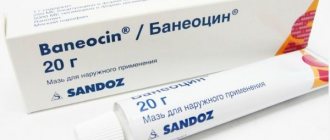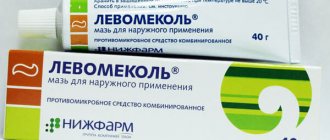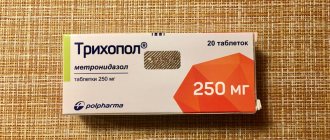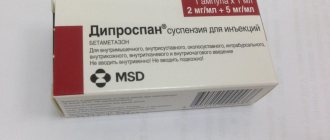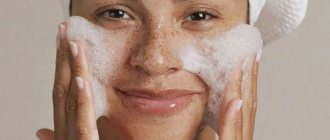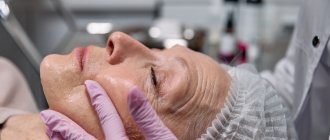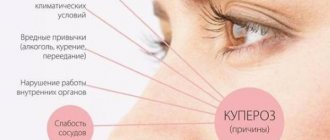Almost every person is faced with the problem of problematic skin, which manifests itself in the form of acne and other inflammatory formations on the skin. Very often, such a defect causes a large number of unpleasant sensations and reduces the normal course of life.
When acne occurs, it is necessary to carry out special treatment, which does not easily mask inflammation on the epidermis, but also eliminates the cause of its occurrence. Experts very often prescribe Baneocin for acne.
The use of the complex substance Baneocin allows you to quickly eliminate unpleasant symptoms and cleanse human skin. The drug is designed specifically for the care of problem skin and allows you to eliminate the most complex types of skin defects.
Release forms, composition and description
The medicinal substance Baneocin is used for antibacterial effects on the skin.
Release forms:
- Powder for external application - the substance has a yellow color and a specific odor. For convenient application, the powder tube has a special dispenser. The volume of a plastic jar is 10 g;
- Ointment - thick consistency for external use. Produced in aluminum tubes, 20 grams each, the color of the cream is light yellow and may have a pungent odor.
Ointment Baneocin Baneocin powder
The powder has the following active ingredients:
- Bacitramine;
- Neomycin;
- Starch;
- Magnesium oxide.
The ointment has the following active ingredients:
- Bacitramine;
- Neomycin;
- Paraffin;
- Lanolin.
The choice of drug form depends on the individual characteristics of the body and the complexity of the disease. Most often performed by the attending physician.
Indications for use
Baneocin is recommended to be used after a special type of diagnosis, which allows us to identify the cause of the problem.
Most often prescribed for the following problems:
- Inflammatory formations on the skin with purulent impurities;
- Trophic type ulcers
- Infections caused by staphylococcus bacteria;
- Dermatitis of various types;
- First and second degree burns
- For wound healing after surgical interventions;
- Wounds with purulent formations;
- Eczema of varying severity;
- Comedones and subcutaneous pimples.
It is also recommended to be used as an antibacterial substance against various types of abrasions and skin damage.
Baneocin®
Baneocin® is a combined antibacterial drug intended for external use.
Baneocin® contains two bactericidal antibiotics: neomycin and bacitracin, the combination of which achieves synergistic action. Bacitracin primarily inhibits the synthesis of murein in the cell wall of gram-positive bacteria (and some gram-negative bacteria).
Bacitracin is active primarily against gram-positive microorganisms: Streptococcus hemolyticus, Staphylococcus spp., Clostridium spp., Corynebacterium
diphtheriae ,
and some gram-negative microorganisms:
Neisseria spp.
and
Haemophilus influenzae.
Bacitracin is also active against
Treponema pallidum, Actinomyces spp.
and
Fusobacteria spp.
Resistance to bacitracin is extremely rare.
The effectiveness of neomycin is due in part to an increase in cell membrane permeability due to inhibition of protein synthesis. Neomycin is active against both gram-positive and gram-negative pathogens, such as Staphylococcus spp., Proteus spp., Enterobacter aerogenes, Klebsiella pneumoniae, Salmonella spp., Shigella spp., Haemophilus influenzae, Pasteurella, Neisseria meningitidis, Vibrio cholerae, Bordetella pertussis, Bacillus anthracis, Corynebacterium diphtheriae, Streptococcus faecalis, Listeria monocytogenes, Escherichia coli
and
Mycobacterium tuberculosis.
Also active against
Borrelia
and
Leptospira interrogans (L. icterohaemorrhagiae).
Some strains of staphylococci are resistant to neomycin.
Thanks to the use of a combination of these two substances, a wide spectrum of action of the drug is achieved, with the exception of action against pseudomonas, nocardia, fungi and viruses. Tissue tolerance of the drug Baneocin® is assessed as good; inactivation by biological products, blood and tissue components is not observed.
If the drug is applied to large areas of skin lesions (in violation of the recommended dosage regimen), the possibility of absorption of the drug and its consequences should be taken into account (see sections “Contraindications”, Interaction with other drugs”, “Special instructions” and “Side effects”) .
Baneocin® powder also has a drying, soothing and cooling effect.
Positive properties of the drug and its effect
The use of the substance Baneocin allows you to achieve the following positive properties:
- The drug has a broad effect on the skin and helps eliminate various diseases of the epidermis;
- Antibiotics that are included in the composition are not addictive and can be used for a long time without reducing effectiveness;
- The active components of Baneocin do not penetrate deeply , therefore they have practically no ability to cause side symptoms;
- The result is achieved very quickly and lasts for a long time;
- The drug has the property of activating the natural processes of restoration of damaged cells and blocking their reoccurrence.
The drug can be used both locally and for large areas as directed. Does not have a negative effect on healthy cells upon contact during treatment.
Penetrating into the layers of the epidermis, it quickly eliminates harmful microbes and restores damaged cells. It is well tolerated by the body, so it can be used at an early age.
Advantages and disadvantages of application
A substance for external acne treatment has the following positive and negative qualities.
| Advantages: | Flaws: |
|
|
The effect of a substance on the skin may depend on the characteristics of the body and proper use, depending on the degree of damage to the skin.
Side effects
"Baneocin" is practically invisible on the skin and does not leave an oily film or unpleasant sensations when used.
If you apply it to rashes or affected areas pointwise , the drug will enter the blood in minimal quantities and will not affect the functioning of the kidneys, heart muscle, or nervous system.
In rare cases, in case of overdose, irritation, itching, and dry skin are observed in the treated areas. The use of the drug in case of individual intolerance may result in eczema.
If problems arise, you should stop using the product and immediately consult a dermatologist .
How to use Baneocin correctly?
The result largely depends on compliance with the rules of application. Depending on the release form, there are instructions for use that allow you to achieve the highest level of effect in the treatment of acne.
Baneocin ointment
To treat acne with Baneocin ointment, it is recommended to follow the following algorithm of actions:
- Clean the skin with water or a special product;
- Apply the drug precisely to each inflamed area;
- For a large number of pimples, apply the ointment in a thin layer, avoiding the mucous membranes;
- Leave until completely absorbed and dry;
- It is recommended to apply the ointment before going to bed once a day;
- The course of treatment depends on the severity of the disease, but not less than 7 days;
- It is recommended to use the ointment for several days after acne is eliminated.
When treating with Baneocin ointment for more than 3 weeks, it is recommended to take a break and then repeat the course of treatment.
Powder
To use Baneocin powder, it is recommended to follow the following instructions:
- Cleanse the skin of the face with water or a special preparation without alcohol;
- Using a dispenser, remove a small amount of the substance into the palm of your hand and apply it to problem areas using your fingertips;
- Gently massage the powder into the skin;
- Apply before bed once a day;
- After application, a film forms on the skin, which must be removed in the morning by washing;
- The duration of acne treatment is up to 15 days, after which you should definitely take a break.
For large areas of acne on the skin, the use of powder can be increased up to two times on the recommendation of the attending physician.
How to use
Before using this or that form of the drug, you should definitely consult a specialist. You also need to do a test for the sensitivity of the skin to the constituent components in order to prevent the occurrence of allergic processes.
Ointment
The ointment is applied exclusively to damaged areas of the skin. For maximum results, apply a gauze bandage over the area. You can apply the ointment no more than 3 times a day. You can use up to 1 g of neomycin per day. The dosage for a child does not require adjustment. The duration of the therapeutic course is a week. In certain cases, the specialist may extend the treatment. When prolonging treatment, the dose used should be reduced by 2 times.
Powder
The medicine in this form is convenient to use as a powder on the umbilical wound, as well as for healing scratches. Used to treat injured skin areas. The powder can be used no more than 4 times a day. It must be applied in a thin layer. Up to 200 g of powder can be used per day. For long-term treatment, the dosage should be reduced to 100 g per day.
Important Features
To achieve more visible results in treatment, it is necessary to adhere to the following important features:
- Do not use the substance in large quantities ; it is recommended to strictly follow the instructions for use. Otherwise, increased dryness of the epidermis may occur;
- For wounds and inflammatory formations that tend to secrete fluid, it is recommended to use powder;
- When using powder to treat acne, do not apply the substance to the eyes or mouth;
- Before starting treatment, you must consult a dermatologist and undergo diagnostics;
- In the presence of liver and kidney diseases, the dosage should be reduced and the patient’s well-being monitored;
- When treating acne, crusts may form , which are not recommended to be eliminated;
- Before starting acne treatment, it is recommended to test for individual sensitivity to the components.
It is not recommended to use Baneocin ointment against acne before going outside, as direct sunlight can cause irritation and burns on the epidermis.
Use during pregnancy and lactation
The drug Baneocin can be used during pregnancy and breastfeeding.
However, the dosage is selected individually, taking into account the following features:
- Apply Baneocin point-wise only to the location of the problem;
- Do not use the substance in the first trimester of pregnancy;
- Do not use Baneocin for a long time;
- Use only in cases of urgent need, since the existing antibiotics in the substance tend to negatively affect the health of the fetus;
- When using Baneocin during breastfeeding, care should be taken to ensure that the substance does not come into contact with the baby’s mucous membranes.
During treatment with Baneocin, it is recommended to carefully monitor the well-being of the pregnant woman.
Use in childhood
The use of Baneocin in childhood requires compliance with the following features:
- The substance is used from the first days of life on the recommendation of the attending physician;
- Application is carried out only on a specific area of the body, prohibited for large areas;
- It is recommended to use powder to treat the umbilical cord;
- Use is prohibited for diseases of internal organs, as well as for allergic dermatitis in a child.
Pediatricians recommend short-course treatment with Baneocin under the supervision of a specialist.
Possible analogues
If necessary, medications can be prescribed that have a similar effect on the human body as Baneocin.
The most effective include:
- Bactroban is an ointment that contains an antibiotic for the treatment of acne and other types of skin diseases. It has antibacterial and healing properties on the skin. Cost 440 rubles ;
- Levomekol - has similar effects on the skin and will help get rid of acne. Prescribed with caution during pregnancy. It has the quick property of relieving inflammation and destroying bacteria that cause purulent formations. Cost 60 rubles ;
- Lincomycin is a topical antibiotic used to eliminate inflammatory formations, including acne. The drug is approved for use from the age of 1 month as prescribed by a pediatrician. Cost 260 rubles .
Bactroban Levomekol Lincomycin
When using Baneocin analogues, it is necessary to study in detail possible complications and adverse reactions of the body.
special instructions
The shelf life of the medicine in powder form is 24 months from the date of manufacture, in the form of ointment - 36 months. Store at room temperature.
If the substance gets into your eyes, rinse immediately with water.
Before taking the drug, you need to check the microflora that caused the dermatological disease for susceptibility to its constituent elements.
When taken simultaneously with other medications, you should monitor the body’s reaction, and if something happens, immediately consult a doctor.
If a person has problems with the functioning of the kidneys and liver, then he needs to constantly undergo urine and blood tests.
